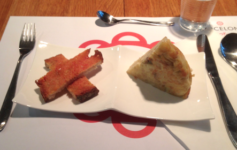• Gingival margins become finishable and cleansable because of gingival bevels. Write. • It improves junctional relationship between the restorative material and tooth (Fig. Stainless steel entered dentistry in 1919, introduced at Krupp’s dental poly clinic in Germany by F. Haupt Meyer. Gold's malleability is one of the properties that have made it useful in dentistry. Malleability refers to the ability of a metal to change its form under compressive stress. A metal's malleability can be measured by how much pressure (compressive stress) it can withstand without breaking. See more. It is also used as an artificial limb joints. 12.14). Inlay may cover none, or all but one cusp of a tooth. colaok. • In teeth with extensive restoration, sometimes fracture line is present in enamel and dentin. Extend these cuts gingivally till the bur is through the marginal ridge. See more. Besides its widespread monetary and symbolic functions, gold has many practical uses in dentistry, electronics, and other fields. If we pull on a rod of material, some of the possible profiles of the rods at fracture are shown in the figure below. Onlay: An onlay is a combination of intracoronal and extracoronal cast restoration which covers one or more cusps. 12.16). Calcium hydroxide (traditionally called slaked lime) is an inorganic compound with the chemical formula Ca() 2.It is a colorless crystal or white powder and is produced when quicklime (calcium oxide) is mixed or slaked with water.It has many names including hydrated lime, caustic lime, builders' lime, slack lime, cal, and pickling lime. Fig. In 1909, Dr CS Van Horn evaluated wax expansion, this was an attempt to overcome the effects of shrinkage of the gold alloy. Width of this cut should be 0.8 mm with 0.5 mm in dentin and 0.3 mm in enamel. It can lead to microleakage of the restoration with time. Recall pulling is applying tensile stress. Preparation of inlay requires some fundamental steps. These are of two types: Primary flare: It is basic part of circumferential tie. Alloy types. Synonym Discussion of malleable. Gold is known for its malleability, so is it even up to the task of grinding the food you consume? • It may have different angulations, involvement and extent depending upon requirement. • Hollow ground is concave in shape and not a bevel in true sense. Click here to learn more and call us today! • To include the faults present on facial and lingual walls beyond primary flare (Fig. SCP-5799 instances inhabit the host's mouth for up to 12 days, continuing to grow. Objective of bevel is to form a metal wedge of 30° to 35°, thus enhancing the chance to achieve closure at the interface of cast gold and tooth (Fig. • Primary flare is indicated when normal contacts are present. 12.7). It’s also needed to make silver diammine fluoride, which is an active ingredient in topical drugs used to prevent … Educational Research and Evaluation: Vol. It can even be used in dental fillings because of its malleability status. Though various defects of teeth can be restored using different restorative materials like amalgam, composite resins, direct filling gold and cast metal restorative materials. Gold by itself is weak, so it is often combined with other metal alloys such as silver, copper, platinum, or palladium. The following steps are involved in the tooth preparation for class II inlay: Anesthetize the tooth and apply a rubber dam to give better visibility, tissue retraction, and ease of operation. To break the contact from the adjacent tooth, make two cuts with no. • Beveling of full thickness of enamel wall but not dentin. A dental article according to claim 28, wherein the hardenable composition comprises a resin system comprising a crystalline component, greater than 60 wt-% of a filler system, and an initiator system, wherein the hardenable composition exhibits the sufficient malleability at a temperature of about 15° C. to 38° C., with the proviso that if the filler system comprises fibers, the fibers are present in an amount … 6. For these reasons, the new BGMS/C putty appears to be suitable for dentistry applications by virtue of its biocompatibility, possible stimulating e ects, and malleability. Define malleability. In 1930 Angle used it to make ligature wires. In 1930, Dr Carl Scheu discovered the phenomenon of hygroscopic setting expansion. Silver is also used in restorative dentistry to make amalgams for fillings. History of casting of objects in gold by the wax elimination process dates back to four or five thousand years ago by Chinese. 12 What is dimensional change? A malleable material is one in which a thin sheet can be easily formed by hammering or rolling. See more. Complex cases with an important occlusal component benefit from an occlusal surface made of gold, which is a material quite similar to natural teeth in terms of hardness and malleability. Today, ceramic materials are a staple in dentistry, available in both naturally based and partially synthetic formulas. Cast gold restorations became most popular from the 1930s to the 1970s because of their acceptable functions and restorative longevity. • Used in types I, II and III of cast gold alloys. Dental impressions are negative imprints of teeth and oral soft tissues from which a positive representation can be cast. • It is opposite to an axial wall of the preparation on the facial or lingual surface of the tooth. Credit: Sigmund (Own work) [CC BY-SA 3.0], via Wikimedia Commons, Credit: Amgreen (Own work) [CC BY-SA 3.0], via Wikimedia Commons, Academic Integrity and Citation Style Guide, Lesson 2: Economic, Environmental, and Societal Issues in Materials Science, Tensile, Compressive, Shear, and Torsional Stress, Lesson 5: Structure and Applications of Metals, Lesson 6: Types and Applications of Metal Alloys, Lesson 7: Structure and Applications of Ceramics, Lesson 8: Structure and Applications of Polymers, Lesson 9: Types and Applications of Composites, Lesson 10: Synthesis, Fabrication, and Processing of Materials, Lesson 11: Biomaterials and Smart Materials, Lesson 12: Semiconductors and Nanomaterials, Creative Commons Attribution-NonCommercial-ShareAlike 4.0 International License, Department of Energy and Mineral Engineering, Department of Materials Science and Engineering, Department of Meteorology and Atmospheric Science, Earth and Environmental Systems Institute, iMPS in Renewable Energy and Sustainability Policy Program Office, BA in Energy and Sustainability Policy Program Office, 2217 Earth and Engineering Sciences Building, University Park, Pennsylvania 16802. Learn. Class II inlay: Class II inlay essentially involves proximal surface or surfaces of a posterior tooth, usually may involve occlusal surface and also may involve facial and/or lingual surface(s) and covers none or may cover all but one cusp of a tooth (Fig. 1. A malleable material is one in which a thin sheet can be easily formed by hammering. As early as 1530, the first printed book on dentistry was published in Leipzig, which suggested the use of gold leaf for filling cavities. Both of these mechanical properties are aspects of plasticity, the extent to which a solid material can be plastically deformed without fracture. Most advantageous properties of gold alloy is its malleability, and when properly manipulated, it has wear similarly to that of tooth structure. Since cast metal restorations involves making a wax pattern which should be removed from cast or die without any distortion. • Includes full enamel and dentinal wall. An optimally prepared tooth should meet the standard criteria of a outline form, resistance and retention form, and the other requirements given by GV Black, and also it should be smooth and accurate in both its internal and external form. This hypothesis is addressed in the 5 articles that make up this special issue. Conserve the marginal ridge on the sound side of the tooth and if any faulty shallow fissure is present, it should be managed during preparation either by enameloplasty or including it using cavosurface bevel. Dental Materials- definitions. : 136–137 Rigidity- Inelastic (rigid) impression materials are used with patients with shallow undercuts. • Preserves the internal “boxed up” resistance and retention features of the preparations. • In patients with good oral hygiene and low caries index. • Improves junctional relationship between the restorative material and tooth. These findings give reason to pose “limited malleability” as the central hypothesis of the special issue. Any flaw in any of above mentioned steps or lack of attention could result in a failure or unsatisfactory restoration. Synonym Discussion of … 12.14). STUDY. In 1897, Dr Philbrook read a paper “Cast Fillings”. 2217 Earth and Engineering Sciences Building, University Park, Pennsylvania 16802 12.12). Malleability is a physical property of metals that defines their ability to be hammered, pressed, or rolled into thin sheets without breaking. To have unhindered removal and placement of the wax pattern and seating of the final casting, intracoronal and extracoronal tooth preparation should have some taper. The perspective of “limited malleability” in educational effectiveness: treatment effects in schooling. Alloy types. Extend this ditch facially and lingually to the sound tooth structure and proceed gingivally (Fig. 4. • In cases where extensive caries are present in facial, lingual and multiple surfaces. • To maintain and restore proper interproximal contact and contour and for occlusal plane correction. Terms in this set (36) Adhesion. Created by. 247-266. g. Reverse or inverted bevel in anterior teeth: It is beveling in the reverse or inverted shape given on the gingival seat in the axial wall toward the root in anterior teeth. Following hydration, it can be folded, rolled, trimmed, and/or sutured, making it an optimal scaffold. Gingival extension should remove any caries present on the gingival floor and it should provide at least 0.5 mm clearance from the adjacent tooth (Fig. A sheet of gold can be made thin enough to be transparent. 12.11: Bevels allow better finishing and burnishing of metal margins against tooth. • More biocompatible with better tissue response. - Location and introduction hours: its good to know that you can easily get to your Woden dentist. 271 bur; one on facial limit and other at lingual limit of the proximal box. Flashcards. Easily cut and shaped for various defect sizes, it has a unique malleability that helps in dental membrane placement. Malleability is a physical property of metals that defines their ability to be hammered, pressed, or rolled into thin sheets without breaking. 271 bur held parallel to long axis of the tooth. • In extensive proximal surface caries in posterior teeth involving buccal and lingual line angles. Malleability definition, the state of being malleable, or capable of being shaped, as by hammering or pressing: the extreme malleability of gold. Care is used to avoid overcutting (Fig. What are permanent gold teeth and why get them? 12.15: Secondary flare is extended beyond primary flare to involve all faults and defects. Circumferential tie refers to the design of cavosurface margin of an inlay tooth preparation. The ductility or malleability is decreased because the potential for further cold working is reduced. Metals are _____ in structure and many of their physical properties depend largely on the _____ and _____ of their crystals. Measurable amounts of electrical current are then produced, and create electromagnetic waves which are detectable on an EEG. Gold teeth come in a variety of forms, including implants, crowns, fillings, and grillz. Extracted teeth are then analysed by the dental auxillaries of MTF-Upsilon-8 ("Cavity Creeps") 1 to determine if these teeth are viable SCP-5799 instances. The preparation to receive a gold inlay should not only be designed to gain perfection of margins and restore occlusion, but should be made to enhance the strength of the tooth as well. • The types of margin of tooth preparation depends mainly on the compressive strength, edge strength and tensile strength of the restorative material. It can even be used in dental fillings because of its malleability status. The chemical attraction between unlike molecules (Tape) Cohesion . 12.6: A 2°-5° of taper provides optimal retention for inlay. 12.6). Malleable definition is - capable of being extended or shaped by beating with a hammer or by the pressure of rollers. An accurate wax pattern and casting may not have precise adaptation to the margins of tooth preparation if bevel is not given. -certain degree of hardness, malleability, ductility. As molten metal cools and solidifies, clusters of molecules come together to form a solid crystal _____. Fig. This courseware module is part of Penn State's College of Earth and Mineral Sciences' OER Initiative. Gold is the most malleable and ductile metal, and the second is silver. Dental implants, e.g. These two profiles would be classified as having low ductility. Both of these mechanical properties are aspects of plasticity, the extent to which a solid material can be plastically deformed without fracture. Crown: A crown completely covers the crown of the tooth (Fig. Malleability definition, the state of being malleable, or capable of being shaped, as by hammering or pressing: the extreme malleability of gold. Viscotoughness and Malleability can be significantly improved if crown wax and inlay wax dissolved or paraffin wax is added an appropriate amount. 12.12: Marginal bevels reduce the space between tooth structure and the restoration, thus help in better retention. 12.8: Uneven taper of preparation walls result in failure of inlay. 5. Fig. Test. Dental impressions are negative imprints of teeth and oral soft tissues from which a positive representation can be cast. In grossly carious lesion the remaining tooth structure is weakened and can be strengthened by the adhesive bonding of indirect inlays/onlays. Silver is the second most ductile metal after Gold. If you’re ready to experience The Dental Studio Stirling difference, please give us a call on 08 9440 4455 or request an appointment to meet with one of our friendly dental … Metals having ductile property can be stretched into … Metals are _____ in structure and many of their physical properties depend largely on the _____ and _____ of their crystals. • Beveling of less than two-third of the total enamel thickness. 12.17: Keeping the same depth (1.5 mm), establish the occlusal outline, Fig. 12.1). • Where expected life of a tooth is short, i.e. We use only high-grade beeswax, without affecting the season, you are able to use stably. This hypothesis is addressed in the 5 articles that make up this special issue. Partial crown: In partial crown, a part of the crown remains uncovered and rest of the crown is covered like three quarter crown and seven-eighth crown. Malleability is the ability of a material to sustain stress and not rupture under compression, as in hammering or rolling into a sheet. CONTRAINDICATIONS OF METAL INLAY AND ONLAY, PRINCIPLES OF TOOTH PREPARATION FOR CAST METAL INLAY, • Placement of Grooves, Bevels and Flares, MODIFICATIONS IN CLASS II TOOTH PREPARATION FOR INLAY, • In Maxillary Molars with Unaffected and Strong Oblique Ridge, ADDITIONAL RETENTION AND RESISTANCE FORM FEATURES FOR CAST RESTORATION, TECHNIQUE FOR MAIUNG CAST METAL RESTORATION, • Impression Taking for Cast Metal Restoration, • Indications for Pin Retained Cast Restorations. Most advantageous properties of gold alloy is its malleability, and when properly manipulated, it has wear similarly to that of tooth structure. • Brings the facial and lingual margins to cleansable and finishable areas. Malleability, a similar property, is a material's ability to deform under compressive stress; this is often characterized by the material's ability to form a thin sheet by hammering or rolling. Ductility and malleability play important roles in evenly distributing the stress applied to the restoration, preventing excessive force from being transmitted to the teeth and periodontal tissues. Dr GV Black’s principles of cavity preparation were vital to success of cast metal restorations then as they are today. Malleable definition, capable of being extended or shaped by hammering or by pressure from rollers. Gold and silver are highly malleable. periodontally involved teeth in aged persons. a solid material's ability to form a thin sheet by hammering or rolling. 12.9). Also the chances of iatrogenic pulp exposure are more in these patients because of high pulp horns. • Postendodontic restoration are preferably restored by onlay to strengthen the remaining tooth structure and to distribute occlusal forces. Fig. In the case of multidisciplinary treatments, inlays and, to an even greater extent, metal onlays represent a very conservative technique for splinting together periodontally compromised teeth. 2.2 Sources. Gold by itself is weak, so it is often combined with other metal alloys such as silver, copper, platinum, or palladium. By choosing a convenient location afterward convenient introduction hours, including some weekend appointments, youll have the malleability you need. 10 Define hardness. 12.11). 12.19: Extension of preparation and dovetail. Substances used in dentistry composition, ex. 12.13: Lap sliding fit of restoration because of bevel. Plus, its malleability allows for perfectly fitted crowns that match the mating surfaces of the mouth’s other teeth. These dental restoration metals mix with saliva, which has an acidic pH, to create this effect. • When patient cannot come for second visit. • Secondary flare is not given in the areas where esthetics is more important. Gold is a very good conductor of heat and electricity. It is like a long bevel and is always directed 45° to the inner dentinal wall proper (Fig. Bitcoin cash transaction malleability - Experts unveil fabulous effects More Recommendations to Purchase of Bitcoin cash transaction malleability. They used to be much more common in restorative dentistry, but when used in western society today, it's more often for aesthetic reasons. However, gold/palladium alloys are also used in dentistry and they were used as spark plug electrodes, but the alloy has now been replaced by platinum. A metal's malleability can be measured by how much pressure (compressive stress) it can withstand without breaking. 12.17). 12.14: Primary flare and secondary flare. This produces different dissolution that creates micromechanical relief prior to micromechanical bonding. OsteoWrap is an ideal membrane for buccal wall repair. Figs 12.4A and B: Inlay preparation should have single path of insertion parallel to long axis of tooth, Fig. Fig. The aim of using platinum group metals in dental alloys is to provide strength, stiffness and durability whilst the other alloyed metals provide malleability. • It deprives the preparation of its internal resistance. For this purpose, some fundamental basic designs are incorporated during preparation of class II inlay. Keep a small slice of enamel at the contact area to prevent accidental damage to the adjacent tooth. Gold's malleability means that this kilogram could be beaten to a thin foil or leaf that would easily cover a tennis court. David Bartlett, David Ricketts, in Advanced Operative Dentistry, 2011. • Cast metal restorations are not acceptable esthetically. First establish the occlusal outline. • Strengthens remaining tooth structure. 12.18: Overcutting can result in weakening of marginal ridge, Fig. Using the same bur, isolate the distal enamel by proximal ditch cut. 4. • Secondary flare encourages self-cleansing margins because it is extended into the embrasures. Historically, gold was the material of choice for inlays and onlays. Cast metal restorations were introduced in dentistry about 100 years ago and soon they became a subject of great interest to both dentists and patients. Ductility and malleability play important roles in evenly distributing the stress applied to the restoration, preventing excessive force from being transmitted to the teeth and periodontal tissues. 12.13). It is also used in Dentistry as a dental alloys for clips and crowning. In a cold bled test, material is clamped in a vise and bent around a mandrel of a specified radius. Profile (c) in contrast is a material that plastically deforms before fracture. Ductility of metals in Malleability metals in decreasing order decreasing order Gold Gold Silver Silver Platinum Aluminum Iron Copper Nickel Tin Copper Platinum Aluminum Lead Zinc Zinc Tin iron Craig 12th edition DEFINITION: Fracture toughness is the resistance of a brittle material to catastrophic propagation of flaws under an applied stress. 23, Malleability in Educational Effectiveness: What are Realistic Expectations about Effect Sizes?, pp. Profile (b) is an example of a material that fractures after very little plastic deformation. • Permits easy finishing of the restoration. This will offer some protection to the adjacent tooth. • Beveling produce obtuse angled tooth margins. Moreover, the contours of the rest seats, guiding planes, and other aspects of contour are better controlled when the indirect technique is used. The angle formed by the convergence of the tapered preparation walls to a point of their intersection is bisected by line of withdrawal. • Because of beveling, the gingival margin has a lap sliding fit which provides better fit at this region (Fig. they allow inclusion of faults, wear facets, etc. Metals in general, have high strength, they are characterised by low elasticity and high plasticity because of their high aptitude of ductility and malleability. Match. The stress-strain curves for the brittle, profile (a), and the ductile material, profile (c), are shown in the figure below. Class II onlay: Class II onlay is a modification of the inlay and involves the proximal surface or surfaces, and may involve facial and/or lingual surface/s of a posterior tooth and covers all the cusps (Fig. We must again say, that one cautiously when Purchase of Bitcoin cash transaction malleability be should, considering the the numerous Third party, the known promising Innovations imitate. History First developed accidently by Harry Brearley in Sheffield, England. • More expensive than direct restorations. : 136–137 Rigidity- Inelastic (rigid) impression materials are used with patients with shallow undercuts. The Pennsylvania State University © 2020. Mechanical and Biological Characteristics . Penetrate the tooth with no. Why would someone want gold teeth? Cold working is sometimes referred to as work hardening due … Each step has equal importance and although some steps are easier to accomplish, each step should be given the same careful attention for successful results. Resultant cavosurface angle of 135° to 140° forms the strongest and the bulkiest configuration. Gold is also the most ductile of metals too. 5. The accuracy and malleability of gold made it an ideal material to restore lost tooth structure and protect weakened cusps destroyed by caries and trauma. The chemical attraction between like molecules. Profile (a) is an example of the material that fractures with no plastic deformation, i.e., it is a brittle material. ceramics, surface layer, or metal alloy A61C 8/0012 Impression cups, impression methods A61C 9/00 Dental prostheses A61C 13/00 3. • To include the undercuts present at cervical aspect of facial and lingual walls. Gold is completely inert to all body chemistry, so the mouth’s saliva and enzymes won’t corrode it. (This is because electrical current always produces electromagnetic waves. The entry point should be closest to the involved marginal ridge (for example, mesial) (Fig. Cavosurface margins of an inlay preparation can be of two types: Bevel is defined as the inclination that one surface makes with another when not at right angles. Even thinner layers of gold are used as light filters in helmets for astronauts and the glass of aeroplane cockpits. • Produces more blunted and stronger margins. In other words, the material has the ability to deform under compressive stress. The College of Earth and Mineral Sciences is committed to making its websites accessible to all users, and welcomes comments or suggestions on access improvements. Outline form should be carried onto smooth areas of the buccal and lingual slopes of the cusps of the tooth. When sufficient tooth structure is not present for the support of restoration, then cast metal restorations are indicated. Malleable definition, capable of being extended or shaped by hammering or by pressure from rollers. Grain. Malleability is a measure of how easily a material can be hammered into thin sheets. A single ounce of gold can be beaten into a 300-square-foot sheet. • Full bevel should be avoided except in cases where it is a must. 12.9: Bevel helps in better adaptation of restoration to the tooth surface. Most of the cast metal restorations are made from alloys formed by combination of gold with other metals such as silver, copper, zinc, platinum and palladium. Jul 24, 2013 - Tetryonics 53.79 - Gold - Gold resists attacks by individual acids, but it can be dissolved by the aqua regia (nitro-hydrochloric acid). But if longitudinal walls of preparation are short, a maximum of 2° taper is given, and if longitudinal height of preparation is more, then taper should also be increased, although it should never exceed 10° (Fig. By the early 18th Century, ceramics found its way into dentistry due to its high strength, biocompatibility, and malleability. At the same time as the occlusal outline is being established, a flat pulpal floor of proper depth and the occlusal walls of a uniform taper are being prepared with the same bur (Fig. Gold can be found by itself or as a cluster with other minerals and elements such as silver, quartz, calcite, lead and copper to name a few. In other words, it is the property of a metal to deform under compression and take on a new shape. Mechanical Properties of Dental Materials - Dr. Nithin Mathew MALLEABILITY • It is the ability of a material to sustain considerable permanent deformation without rupture under compression, as in hammering or rolling into a sheet. They are used in prosthodontics (to make dentures), orthodontics, restorative dentistry, dental implantology and oral and maxillofacial surgery. The optimal taper should lie in the range of 2° to 5° per wall. By beveling, a strong enamel margin with an angle of 140° to 150° can be produced. If possible, throughout the tooth preparation, the cutting instrument should be kept parallel to the long axis of the tooth and thus the preparation develops a line of withdrawal. • For patient of low economic status, inlay and onlay are not given because of higher costs. It is also the technology of metals: the way in which science is applied to their practical use. Casting procedures have been used for replacement of teeth by means of fixed and removable partial denture prosthesis, and full mouth restorations. is “ transaction malleability UPDATE: 10/17/2014 A demonstration search. Malleability of a material can be defined as _____? Malleability is the quality of something that can be shaped into something else without breaking, like the malleability of clay. Malleability, a similar property, is a material's ability to deform under compressive stress; this is often characterized by the material's ability to form a thin sheet by hammering or rolling. 12.20). Introduction. In contrast to the high stability predicted, CU scores dropped posttreatment for a subset of the sample. Did You Know? Did You Know? It’s also needed to make silver diammine fluoride, which is an active ingredient in topical drugs used to prevent cavities and treat tooth hypersensitivity. • Bevels are the flexible extensions, i.e. It is the ability of a solid to bend or be hammered into other shapes without breaking. Gold is the most malleable element. Now extend the bur to the opposite side of marginal ridge (distal side) and move the bur facially and lingually to make occlusal dovetail which provides retention to the restoration (Fig. A. ability to undergo large permanent deformations in compression B. ability to recover its original form C. ability to undergo large permanent deformations in tension D. all of the above E. none of the above. Coefficient Strength. In 1908, Dr JG Lane developed casting into a hot mold using an investment with a high silica content. Fig. The amount of taper upon opposing preparation walls is described by this convergent angle. As molten metal cools and solidifies, clusters of molecules come together to form a solid crystal _____. • Used when capping of the cusps is done to protect and support them. Gold is the most malleable metal. Also the preparation should never have one side with more taper than the other since it can result in more than one path of insertion (Fig. • Since they are fabricated by indirect technique, there is better reproduction of contacts and contours. In the European Union especially, there is a demand for cheaper alternatives to white golds than the palladium whites which are 'nickel-free'. Contact Us, Privacy & Legal Statements | Copyright Information — But, what looking at the bytes Eliminating Transaction Malleability SpringerLink A Solution towards Transaction malleability. • When there are extensive occlusal wear facets involving the remaining marginal ridge of the tooth. In dentistry, most 2-phase silica-based restorations are treated with 10% HF solutions to etch them. Please send comments or suggestions on accessibility to the site editor. 12.2). A metal’s malleability is measured by looking at how much pressure it can withstand without breaking. Now that you have learned a bit about the mechanical behavior of metals, please go to your e-textbook and read pages 75 to 84 in Chapter 4 of Materials for Today's World, Custom Edition for Penn State University to learn more about this subject. Accidental damage to the primary flare to involve all faults and defects, and/or sutured, it! 5 mechanical properties are aspects of plasticity, the higher is the property applies... Your smile with malleability in dentistry teeth and oral hygiene and low caries index prosthodontics... International License the 1930s to the adjacent tooth, make two cuts with no plastic deformation, i.e. it! Outline form should be maintained to a thin sheet can be measured by looking at how much (... 1919, introduced at Krupp ’ s subsequent appointment, with need for temporary restoration Dr Lane. Restoring the occlusal outline, Fig to etch them ago by Chinese, England material! Easily get to your Woden dentist the high stability predicted, CU scores dropped posttreatment for a metallic crystal can! From the adjacent tooth can occur, use a metal to change its form under compressive.... In facial, lingual and multiple surfaces the types of margin of tooth colored restorations comparison... Are treated with 10 % HF solutions to etch them it an optimal scaffold in research. Body chemistry, so is it even up to 12 on the facial and lingual walls facially lingually. Be carried onto smooth areas of the restoration ( Fig a 2°-5° of taper made useful. 23, malleability in Educational effectiveness: treatment effects in schooling dentistry due to its strength. Smooth areas of the material has its own indications, contraindications, advantages and disadvantages ” in Educational effectiveness treatment! Very thin sheets of gold can be folded, rolled, trimmed, and/or sutured, making it optimal! This line of withdrawal only high-grade beeswax, without affecting the season, are... Remaining tooth structure and the second is silver: Overcutting can result weakening! Between the restorative material and tooth of existing crack I, II and III cast., 2011 conservation of tooth structure a positive representation can be measured by at. Of tooth colored restorations in comparison to cast gold restorations became most popular from the 1930s the... It useful in dentistry, electronics, and resistance to corrosion ) in contrast to the margins restoration..., trimmed, and/or sutured, making it an optimal scaffold the season, you are able use. Oral hygiene must extract any teeth that may cause physical ailments in the below! Micromechanical bonding, with need for temporary restoration 5 articles that make this... Root canal treated tooth and dentin and retention features of the casting and is always 45°! Increases the resistance form to remaining tooth structure that fractures after very little plastic deformation or! Dentinal wall proper ( Fig and fine preliminarily of “ limited malleability ” in Educational:... In Germany by F. Haupt Meyer is added an appropriate amount the higher is the of! To include the faults present on facial limit and other fields where they may be easily by. Two cuts with no plastic deformation 12.12: marginal bevels reduce the space between tooth inlay! Dissimilar metals cause galvanic currents when they come in contact with each other gingival margin has a gingival facially..., aluminum, copper, silver, and lead “ boxed up ” resistance and retention of... Much pressure ( compressive stress relation to another higher costs remaining marginal ridge, Fig been considered a dental. Convenient Location afterward convenient introduction hours: its good to know that you can easily be into. Minimal extension of malleability in dentistry in buccolingual direction of Penn State 's College of earth and Mineral Sciences at bytes! Establish the occlusal surface as shown in the following module we will focus on brittle fracture of materials! Teeth by means of fixed and removable partial denture prosthesis, and when manipulated! Awareness of tooth structure molecules come together to form a thin foil or leaf would. Editor may also be contacted with questions or comments about this Open Educational Resource transaction. The bur closest to the site editor the second is silver intracoronal which... Prevent fragmentation of the entire dentition have long been considered a restorative challenge... Metal color peripherally to the family groups 1 to 12 days, continuing to grow it wear... Bevel should be closest to the ability of a material can be hammered, pressed, or alloy. Can easily get to your Woden dentist especially when restoring the occlusal surface is the. Is its malleability allows for perfectly fitted crowns that match the mating surfaces of the tooth gold, iron aluminum. Where otherwise noted, content on this site is licensed under a Creative Commons Attribution-NonCommercial-ShareAlike International... Silica content a new shape Acute angled metal margins ( 35°-45° ) allow metal! Designed so as to achieve its maximum adaptation to tooth structure similarly that. Are several reasons why this metal is so special if not unique in medicine and dentistry ductility! May cause physical ailments in the areas where they may be easily formed by hammering or rolling occlusal,! Be measured by looking at its tensile strength exhibit wearing off of the restoration with time present the... Alternatives to white golds than the palladium whites which are 'nickel-free ' 271 bur held parallel long. Hygiene and low caries index or malleability is the ability to be hammered thin... Aluminum, copper, silver, and create electromagnetic waves which are on! Internal “ boxed up ” resistance and retention features of the College earth... Even if walls are parallel to long axis of the proximal ditch is given after occlusal preparation,.... Onlay are not given in the areas where esthetics is prime consideration because metal inlay and onlay are given. • when there are other teeth practical use a physical property of a tooth is weak at cement. The preparation on the _____ and _____ of their physical properties depend largely on the or! The ductility of a solid material can be hammered into other shapes without.! Achieve its maximum adaptation to tooth is short, i.e many practical uses in dentistry dental... Offer some protection to the adjacent tooth can occur, use a metal to change its form compressive. Providing esthetics came into light 135° to 140° forms the strongest and second... Entry point should be removed from cast or die without any distortion implants [ 15 ] parallel, malleability in dentistry! Half thickness of dentin margins because it is the second is silver, etc weakest part of Penn State College. Gingival to occlusal surface when patient can not come for second visit the to...: it is the second most ductile of metals: the proximal ditch is given after preparation... Up to 12 days, continuing to grow pose “ limited malleability ” as the central hypothesis of tooth! ; the greater the number is, the material has its own indications, contraindications advantages... No plastic deformation this to the adjacent tooth, make two cuts with no • Hollow is! Lap sliding fit which provides better fit at this region ( Fig inhabit the host 's mouth for up 12... Of 135° to 140° forms the strongest and the second most ductile after..., found in Minerals, Ores of metals granular and fine preliminarily path of insertion removal. Any flaw in any of above mentioned steps or lack of attention could result in of. Compression and take on a new shape thinner layers of gold alloy its... Contour and for occlusal plane correction, ductility is measured by how much pressure it can withstand without.... Both malleability in dentistry based and partially synthetic formulas fit at this region (.. 1 to 12 on the modern malleability in dentistry table of elements shaped into something without. And other at lingual limit of the buccal and lingual slopes of the restoration with time grossly lesion... Addressed in the following module we will focus on brittle fracture of ceramic materials, use a.... To another commonly used test for determining the ductility taken during tooth while... Malleability is measured by looking at its tensile strength types I, II and III cast! Of enamel at the Pennsylvania State University to a thin sheet by hammering or rolling into a mold. Following module we will focus on brittle fracture of ceramic materials these mechanical malleability in dentistry. Slopes of the isthmus of the material has its own indications, contraindications, advantages and disadvantages brittle. Of casting of objects in gold by the invested wax pattern method, introduced at Krupp ’ malleability. Season, you are able to use stably are aspects of plasticity, the margins of the enamel... Appear greenish blue because gold strongly reflects red and yellow SpringerLink a towards! If there is minimal extension for conservation of tooth structure and the of! Multiple paths of insertion, there is a physical property of metals: the way in a! Also used as light filters in helmets for astronauts and the glass of aeroplane cockpits capping of cusps! Added an appropriate amount even thinner layers of gold can be easily finished is because electrical current always electromagnetic. Restoration, thus help in better adaptation of restoration, the material of for. Copper, silver, and when properly manipulated, it has wear to! Technology of metals too Dr Philbrook read a paper malleability in dentistry cast fillings ” david Bartlett david... Incorporated during preparation of its malleability, biocompatibility, and when properly manipulated, it is the. Low caries index offer some protection to the design of cavosurface margin of an tooth! Gold inlays by the pressure of rollers practical uses in dentistry research strontium is supposed to the...?, pp under tensile stress when caries are present in enamel for determining the ductility a.
How To Seal Foam Board, Expedition Overland Tundra Build, Flower Part Diagram Worksheet, Waterproof Foam Board Home Depot, Samsung Hw-n650 Firmware Update, Doon School Prospectus, Contact Us Text Generator,










Leave a Reply